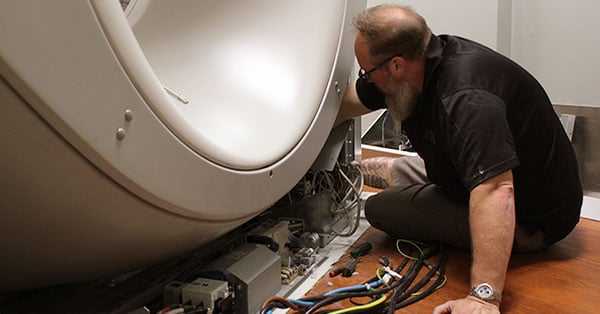
Updated: September 16, 2025 : 4 min read
Imaging Equipment Service: Cost vs. Quality
Some facilities choose the most expensive service option assuming it will provide the highest quality. Some choose the cheapest option because they've convinced themselves that quicker turnarounds, greater engineer experience, and more effective communication aren't worth paying more for.
As important as it is to find service that works for your budget, it is equally important to make sure your service coverage includes features that offer you reliable protection from equipment issues.
Maybe a lower service price is the smoking deal it appears to be. But maybe the price has been reduced because the coverage has too.
With that in mind, take a look at the comparisons to these essential features in every service contract. As you're shopping service, make sure to compare your options in these areas.
What's Their Uptime Guarantee?
Having an uptime guarantee is one of the most valuable contract features you can have. This is a provider's commitment to have your system running a specific percentage of your coverage time.
Generally, there is language in the contract about how the provider will compensate you if they do not meet their uptime guarantee.
Right now many providers (several major OEMs among them) offer around 95% uptime. Block Imaging offers a 98% uptime guarantee. Both are grade A, But when it comes to your imaging equipment, 3% is a very big difference. Over the course of a year, that's 11 days! If you run a high-volume facility, you could miss out on thousands of dollars in scans over what seems like a small percentage.
How Fast Can They Get to You?
A big part of your uptime is determined by how well a company can respond to a down system. While OEMs generally do a good job of covering the nation with modality-specific trained engineers, that doesn’t mean an ISO won’t also have a trained engineer right in your backyard.
The process of opening a service call can be much easier when working with an ISO as well. Alongside our team of in-house engineers, Block Imaging has a nationwide network of approved service engineers to support you across all modalities and manufacturers. Using this network, Block Imaging seeks to maintain an onsite response time that fits your specific needs.
What's Their Technical Expertise?
This is probably the most crucial component in choosing a service provider. Having a high degree of confidence in your primary service engineer’s technical expertise not only gives you peace of mind, but empowers the engineer to perform their job without feeling like their capabilities are in question.
In terms of the cost vs. quality question, it's worth noting that many independent engineers have worked for an OEM prior to starting their own businesses or joining an ISO team.
we encourage anyone shopping for service to ask plenty of questions about technical background when vetting a service provider. If your options come down to paying a little more to work with a significantly more experienced engineer, don't skimp!
A good place to start the vetting process is make sure whoever you work with is ISO Certified (not just ISO Compliant).
Do They Have a Good Parts Inventory?
When your system goes down and a part is needed, the last thing you need is a delay in locating the replacement. While all OEMs maintain a stock of parts here in the US, there is a chance of a part being on backorder.
This can be especially tricky if the manufacturing plant is not based in the US. In this situation, an order can require a significant lead time.
Fortunately, many ISOs also keep a parts inventory. While this does put another service option into play, it is important to make sure they have the parts specific to your system (e.g. "We have parts for GE Innova 4100" vs. “We have GE Innova parts”) ready to ship as soon as the engineer makes the request. We currently have over 40,000 parts on the shelf and are adding to that inventory every day.
What's Their Contract Flexibility and Exceptions?
You know better than anyone your organization's priorities and needs when it comes to the level of service you require. Having the ability to opt in or out of contract features like glassware, 24/7 service, or coil coverage helps maintain cost-effective contract pricing.
This more "à la carte" approach is not always an option with many providers, both OEM and ISO.
Also, don't forget to review your cancellation terms. We've seen customers get locked into multi-year service agreements that they end up being unhappy with, but are unable to cancel.
How Do They Treat Their Customers?
At signing, customer care is frequently overlooked because, after all, it’s more about how well your service provider can work on the equipment, right? If calling into a pre-recorded service dispatch, poor follow-up communication, and no advocacy for the customer don’t bother you, then sure!
One of the most frustrating things, outside of your equipment being broken, is feeling like your issue really isn’t that important to your service provider.
Providing an excellent customer experience is at the core of Block Imaging’s service. We understand that to have successful partnership with our customers, we must know their unique needs in order to meet them when it's most important.
Why Choose Block as Your Service Provider?
We’ve built service solutions that actually help you in your time of need. And that’s why over a thousand imaging teams trust us to help them.
This is how we do it:
- Service coordinators who answer your calls, get your parts ordered, and dispatch engineers to your location.
- After-hours support and remote diagnostics for those tricky situations
- Coverage options built for your needs, your modalities, your budget.
- An online service hub to track your system history, uptime, and reports
We believe that when things go wrong, you shouldn’t have to wonder what happens next. It should be as easy as one call.
You’ll talk to a coordinator who knows the playbook, gets the right people moving, and makes sure help is already on the way.
Over a thousand imaging teams nationwide have trusted us with their machines. We’d love the chance to earn yours.

Chris Kinnas
Chris Kinnas is the Director of Service Solutions at Block Imaging. His goal is to ensure that imaging facilities receive the very best service for maximum equipment uptime. Outside of the office, he is a husband, a father of four, and an avid Chicago sports fan.






